
If somebody told me six months ago that I'd ever play a game as beautiful as Trine, I would have scoffed, and yet here I am, playing its sequel - a game that takes its astoundingly high production values and raises the bar to unimaginable new heights.

So, for anybody who is unaware, Trine 2 is the sequel to Finnish developer Frozenbyte's 2009 side-scrolling fantasy puzzle platformer, which refines and continues to build what I suppose I should be calling the "Trine franchise". All the majesty of Trine is present, though there are a few changes that are definitely worth giving attention to.
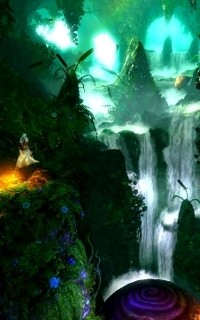 Visually, Trine 2 is a huge step beyond Trine's already stunning environments, with a big emphasis on further meshing foregrounds and backgrounds with the play area (something that, though nicely executed in Trine, has been dramatically improved), with streams and ponds that organically stretch off into the unused axis, fantastic lighting that de-emphasises the two dimensional play area, and enemies that clamber across the foreground foliage to reach you or jump out from behind rubble in the background. The game's 3D models are gorgeous, and the new enemies and giant creatures have let Frozenbyte's animation talent shine.
Visually, Trine 2 is a huge step beyond Trine's already stunning environments, with a big emphasis on further meshing foregrounds and backgrounds with the play area (something that, though nicely executed in Trine, has been dramatically improved), with streams and ponds that organically stretch off into the unused axis, fantastic lighting that de-emphasises the two dimensional play area, and enemies that clamber across the foreground foliage to reach you or jump out from behind rubble in the background. The game's 3D models are gorgeous, and the new enemies and giant creatures have let Frozenbyte's animation talent shine.
Trine 2's atmospheric effects are astounding as well, with huge lighting improvements over the original, and some really immersive weather effects. The presentation of torrential downpours, scalding lava, humid jungles, murky forests, icy blizzards in this game is truly jaw dropping. Sound plays as big a part in this as visual effects, and the ambient, background and foley effects mesh well with the game's stunning visuals and fairy tale presentation (it's not a big part of the game, but the filters applied to music and ambient sound whilst underwater is also particularly neat).
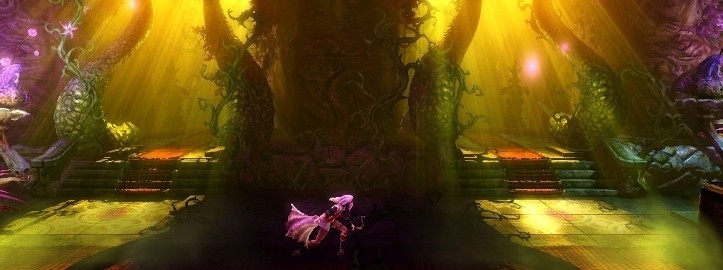
Ari Pulkkinen's talents grace Trine 2, once again providing an enjoyable soundtrack, but this time it's presented via a context sensitive music system that plays more energetic battle tracks when enemies appear. Normally I get pretty excited about dynamic music presentation, but in the case of Trine 2, I felt that when playing, I spent more time frowning every time there was a transition than I did appreciating the tracks themselves.
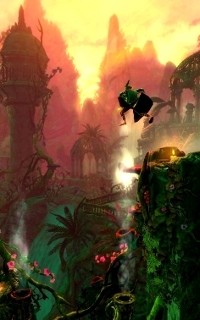 Gameplay wise, Trine 2 uses most of the same elements as its predecessor, with most puzzles completable using each character's skills. There is something subtly different about the presentation of puzzles though, which leads to them seeming less like puzzles and more like environments. This isn't necessarily a bad thing - it definitely makes the game flow more smoothly, but it does diminish the sense of satisfaction for completing a puzzle.
Gameplay wise, Trine 2 uses most of the same elements as its predecessor, with most puzzles completable using each character's skills. There is something subtly different about the presentation of puzzles though, which leads to them seeming less like puzzles and more like environments. This isn't necessarily a bad thing - it definitely makes the game flow more smoothly, but it does diminish the sense of satisfaction for completing a puzzle.
There are a number of new puzzle elements that help give flavour to specific areas and provide new combinations throughout the game's increased length. The most dynamic of these are pipes, which can carry air (that can be used to float players and boxes, as well as create bubbles), fire (that can be used to damage things and boil water), or lava (which is generally liquid death, but can also melt ice). The introduction of bi-directional portals dramatically increases the versatility of other puzzle elements, and there's also an interesting mechanic which requires players to direct or carry water.
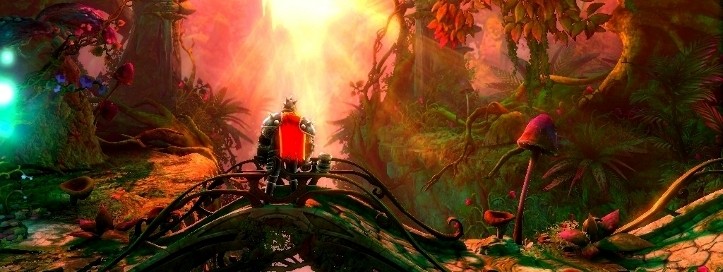
 Combat has a very different feel as well. The first thing noticeable is that there are no skeletons (much to Mim's dismay). There are also a broader range of enemy types with different behaviours, leading to more varied and dynamic combat. This combined with the tendency for enemies to jump out from behind things tends to make encounters a lot less predictable than they were in Trine, where skeletons would either be placed in visible locations on the level, or spawn from very obvious glowing circles on the ground. The lack of predictability leads combat to be more reactionary and less tactical, making enemies feel less like puzzle elements than they did in the first game (this is not a big loss though, as Trine 2's cast of giant creatures are used to fill the role of dynamic puzzle elements to great effect).
Combat has a very different feel as well. The first thing noticeable is that there are no skeletons (much to Mim's dismay). There are also a broader range of enemy types with different behaviours, leading to more varied and dynamic combat. This combined with the tendency for enemies to jump out from behind things tends to make encounters a lot less predictable than they were in Trine, where skeletons would either be placed in visible locations on the level, or spawn from very obvious glowing circles on the ground. The lack of predictability leads combat to be more reactionary and less tactical, making enemies feel less like puzzle elements than they did in the first game (this is not a big loss though, as Trine 2's cast of giant creatures are used to fill the role of dynamic puzzle elements to great effect).
Boss encounters have been significantly revamped, with boss health bars, more frequent placement and justification within the context of the game's story. With two exceptions, boss behaviour does not seem to vary, each encounter has one or two unique environmental elements which can be used offensively (and which I failed to notice on my first playthrough). The other encounters include a major crescendo battle where the health bar is replaced with an indicator showing the boss' vulnerable areas (something I found to be a little unintuitive at first, as the game doesn't make it easy to identify when those areas will or won't be damaged by an attack), and an invulnerable boss that requires a more puzzle style solution (which also suffered from a lack of feedback, but was otherwise a solid and enjoyable encounter).
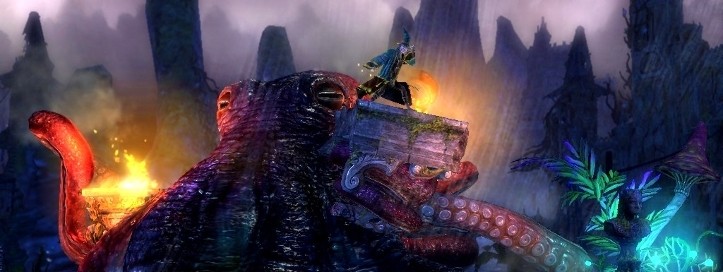
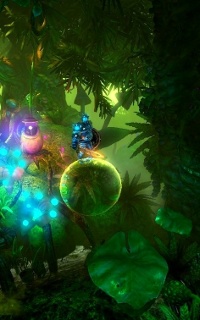 Character levelling and customisation has been streamlined as well, doing away completely with the first game's inventory system in favour of making skill point deployments revocable. While this does remove some handy perks like underwater breathing, extra arrows and resurrection, it does simplify character customisation and gives players the chance to try new skills they're curious about without committing to using them.
Character levelling and customisation has been streamlined as well, doing away completely with the first game's inventory system in favour of making skill point deployments revocable. While this does remove some handy perks like underwater breathing, extra arrows and resurrection, it does simplify character customisation and gives players the chance to try new skills they're curious about without committing to using them.
Energy has been removed from the game, giving Amadeus unlimited levitation power and Zoya unlimited fire arrows. Similarly, Pontius and Amadeus now have no cooldown between item summoning and charging. This removes some of the strategic challenge of managing energy in exchange for allowing players to move more quickly through the game.
Skills have seen some tweaks as well, with Pontius losing the ability to carry things, Zoya no longer sporting the fast quiver skill and Amadeus forgetting how to summon levitating platforms.
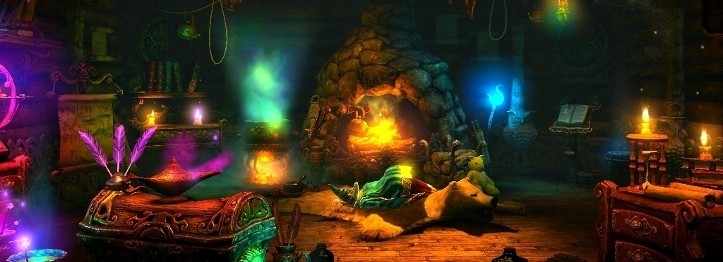
Amadeus now has the ability to levitate most enemies, incapacitating them whilst in the air and stunning them for a short period when they are dropped. Levitated enemies can be carried into the path of arrows and spears, and be used to set off traps. Gesture recognition for summoning seems improved as well (I am told this is a result of any non-linear gesture creating a box - something made possible by the removal of Trine's original floating platform).
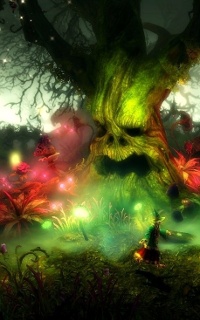 Zoya's range of arrows has been expanded to include frost arrows, allowing her to freeze enemies into blocks of solid ice, which can then be smashed, used as barriers or levitated and dropped onto other enemies. Zoya also has the ability to become invisible for short periods (providing she doesn't attack or touch an enemy), allowing her to sneak past enemies and avoid combat.
Zoya's range of arrows has been expanded to include frost arrows, allowing her to freeze enemies into blocks of solid ice, which can then be smashed, used as barriers or levitated and dropped onto other enemies. Zoya also has the ability to become invisible for short periods (providing she doesn't attack or touch an enemy), allowing her to sneak past enemies and avoid combat.
Pontius can now throw his hammer, killing any enemies it hits in the direction it is thrown. His shield can also be upgraded to do frost damage to enemies whose attacks are successfully blocked, and eventually turning them to ice after enough successful blocks. Pontius can now also block beneath himself, allowing him to block upward travelling fire or arrows, as well as avoid damage from spikes (this type of manoeuvre feels like it should damage enemies as well, but does not).
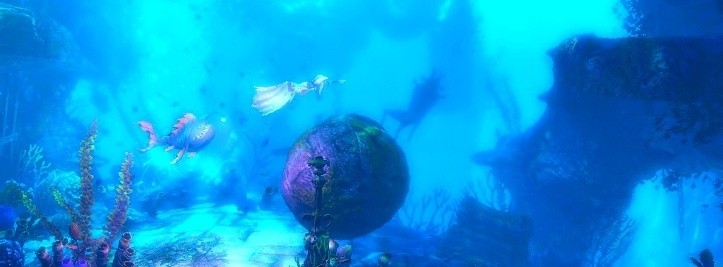
These new skill additions provide a degree of overlap between the characters that was not present in the first game. Pontius's hammer throw and Amadeus' levitate enemies abilities place them partially within the realm of ranged attack. Zoya's frost arrows and stealth skill significantly reduce her vulnerability in close combat and allow her to bypass enemies which might have previously necessitated support from one of the other characters. Amadeus, with the ability to shield himself with levitated enemies and more responsive summoning start to allow him to be effective during combat.
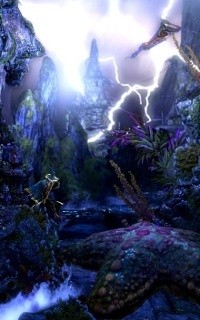 My initial expectations were that this reduced vulnerability and increased practicality would encourage players to focus on a single character and ignore the abilities of the others, but the new skills have been implemented with a degree of care and finesse that, for the most part, still allows each of the characters to feel effective. Pontius has a long cooldown on his hammer throw, and enemies have enough mass/drag when levitated to make tossing hoards of goblins aside fairly impractical. Zoya does feel marginally overpowered, but there are enough puzzles/enemy combinations that necessitate Pontius' shield or Amadeus' summoning abilities to prevent exclusive use during single player play.
My initial expectations were that this reduced vulnerability and increased practicality would encourage players to focus on a single character and ignore the abilities of the others, but the new skills have been implemented with a degree of care and finesse that, for the most part, still allows each of the characters to feel effective. Pontius has a long cooldown on his hammer throw, and enemies have enough mass/drag when levitated to make tossing hoards of goblins aside fairly impractical. Zoya does feel marginally overpowered, but there are enough puzzles/enemy combinations that necessitate Pontius' shield or Amadeus' summoning abilities to prevent exclusive use during single player play.
Trine 2's story is far better structured than its predecessor's, and is more tightly meshed with the game's progression. There are a few plot elements that could have benefited from greater exposure, and the original game's "macguffin" was in my opinion more compelling, and it is harder to recognise what the consequences failure to complete your quest might imply (there is mention of an invasion in the last quarter of the game, but until then it almost seems that the player is the aggressor). These are small rough patches, though and the plot as a whole is fairly coherent and does work with the Trine series' "fairytale" presentation.
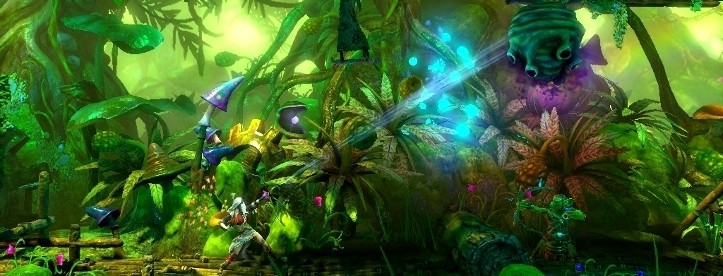
Looking at the game as a whole, it plays very smoothly from beginning to end. The game's pacing and learning curve has obviously been given a lot of attention. The introduction of additional puzzle elements is done slowly, in such a way that the steady climb in puzzle complexity is barely noticeable. There are some elements that feel under utilised (such as the puzzle style boss encounter mentioned above, and a really neat physics walker that is only seen once), but the game is richer with their brief presence than it would be without them.
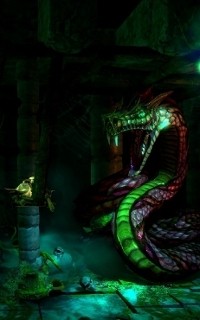 The lead up to Trine 2's ending does feel a bit abrupt. The final boss battle is a nice note to finish on, but it does feel like there's room for a non-combat crescendo leading up to it. It's interesting to note that negative feedback regarding The Tower in Trine (something I personally considered to be one of the best aspects of Trine's game design, but was apparently much more difficult in earlier versions of the game) encouraged Frozenbyte to steer clear of similar seqeunces when building Trine 2.
The lead up to Trine 2's ending does feel a bit abrupt. The final boss battle is a nice note to finish on, but it does feel like there's room for a non-combat crescendo leading up to it. It's interesting to note that negative feedback regarding The Tower in Trine (something I personally considered to be one of the best aspects of Trine's game design, but was apparently much more difficult in earlier versions of the game) encouraged Frozenbyte to steer clear of similar seqeunces when building Trine 2.
I feel like I haven't spent enough time talking about how amazing Trine 2's giant creatures are. In an effort to not spoil the plot or any surprises, I won't list them all, but the giant snail and octopus seen in the official Trine 2 gameplay trailer are definitely my favourites. For the most part, the creatures are utilised as dynamic puzzle elements, bringing what may have otherwise been forgettable puzzles charm and memorability. These larger than life beasts have very small roles within the scope of the game as a whole, but they support the fairytale feel of the game and bring a degree of character and wonder such that I couldn't imagine the game without them.

Moving onto multiplayer gameplay, network support opens up co-operative play to a much broader range of people, allowing me to play a few levels with friends on the opposite side of the globe. In addition to the "classic" multiplayer mode, where only one of each character can be used by any player at any time, Trine 2 has an "unlimited" mode, which allows players to become any of the characters independently of other players (as one would in a single player game).
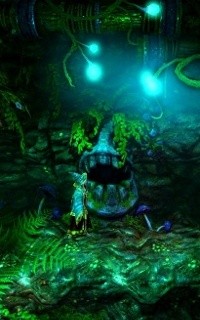 For the most part, the multiplayer games I played with people I knew were enjoyable and rewarding. Having the opportunity to see others' approaches to solving puzzles, and experiment with using multiple characters' skills together is both enlightening and entertaining. In addition to playing a couple of single-levels with people, I also did a single-sitting play through of the entire game with Mim (my wonderful partner and cohort in all things twolofbees.com related), which was a good bonding experience (something I've heard echoed by other couples) and lovely way to spend an evening.
For the most part, the multiplayer games I played with people I knew were enjoyable and rewarding. Having the opportunity to see others' approaches to solving puzzles, and experiment with using multiple characters' skills together is both enlightening and entertaining. In addition to playing a couple of single-levels with people, I also did a single-sitting play through of the entire game with Mim (my wonderful partner and cohort in all things twolofbees.com related), which was a good bonding experience (something I've heard echoed by other couples) and lovely way to spend an evening.
The games I have played with random people have proved to be less pleasant (though this may be because I was approaching the game with the intention of writing a review rather than goofing off). Unfortunately, none of the players I partnered with had microphones, so communication was restricted to text chat - something that tends to be ignored when people are in the middle of combat, are excited about running off on their own or are frustrated by a puzzle. The game could definitely benefit from some way of indicating a specific point on another player's screen to help hammer home friendly directions such as "make a box here," or "this is a trap."
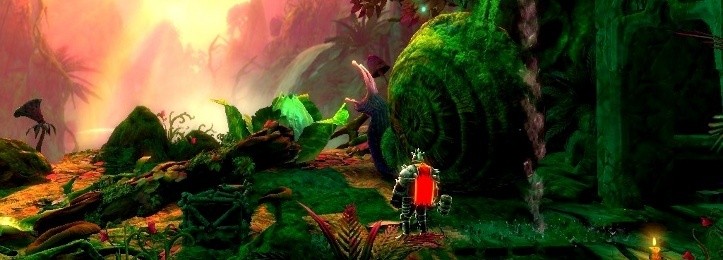
All in all, Trine 2 is a fantastic game. It not only raises the bar well above Trine's originally high standard of presentation and charm, which alone is a massive feat, but also manages to do it for the duration of a much longer game. There are aspects of improved flow that seem to have lessened the impact and reward of individual puzzles, but the game as a whole is still fulfilling and ultimately, more seamless for it.

A note from Cheese
Thanks for reading, and a big thanks to the wonderful people at Frozenbyte who who graciously let me in on the Trine 2 beta. Like its predecessor, Trine 2 is a game I will list as a favourite for a long time. It's been a lot of fun to look at and try to understand what it is that makes the Trine series so special. It's also been fascinating to see how the aspects that I appreciate have evolved between Trine and Trine 2.
I've even been moved to draw up some fan art which you can find on twolofbees.com.
If you're interested, you can also read my review of Trine, and you can find out more about Trine 2 from the official Trine 2 website.
Trine is currently available for for Windows and MacOS on Steam, and a Linux client is being worked on.
You can email me at cheese@twolofbees.com
This article was first published on the 17th of February 2012.